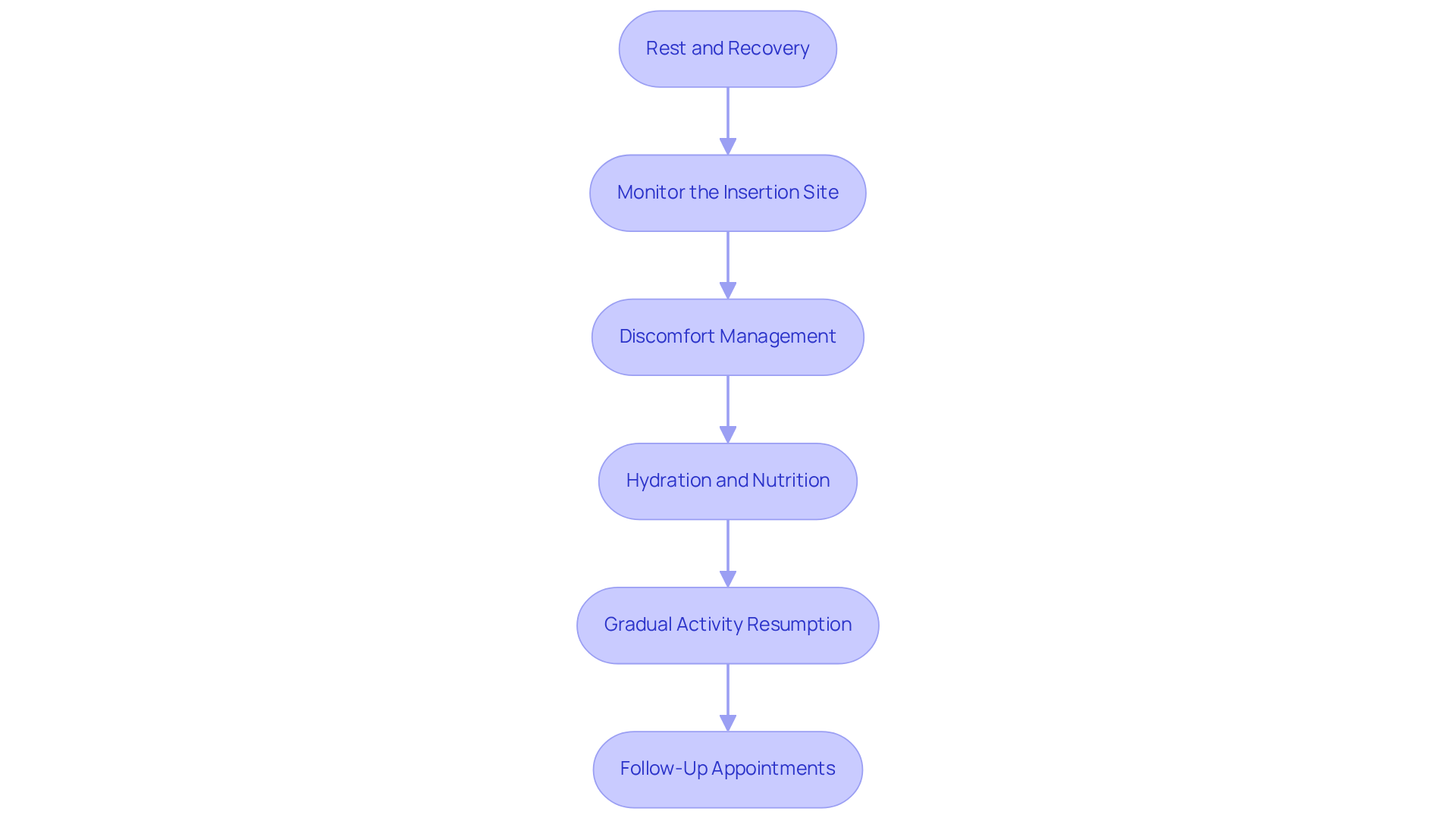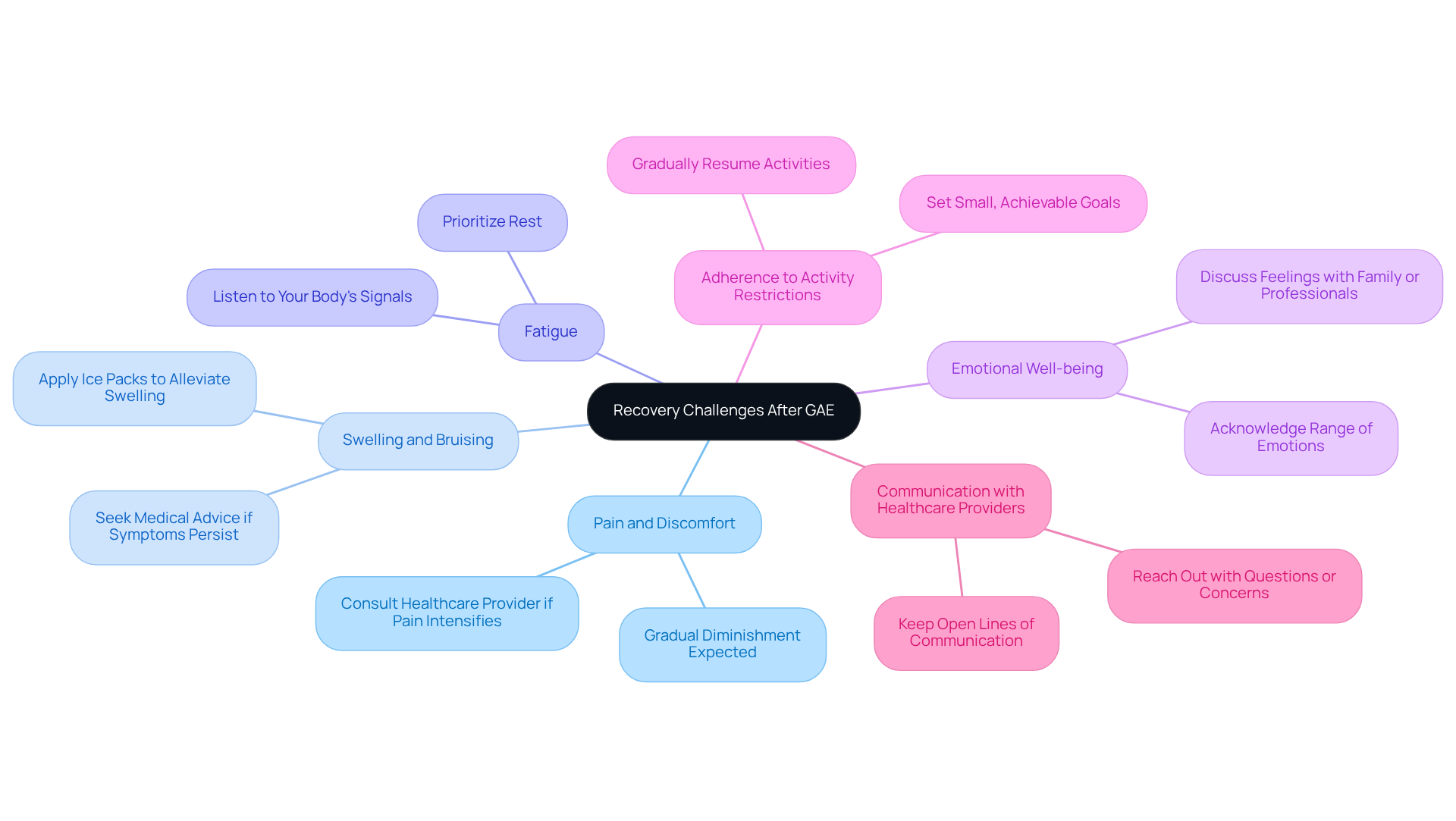


After undergoing Genicular Artery Embolization (GAE), it's essential to prioritize your recovery with some caring aftercare steps. First and foremost, rest is vital. Your body needs time to heal, and taking it easy will support that process. It's also important to monitor the insertion site closely—keeping an eye out for any changes can help catch potential issues early.
Managing discomfort is another key aspect; don’t hesitate to use prescribed medications as needed. Staying hydrated is equally crucial, as it helps your body recover more effectively. As you start to feel better, gradually resuming your activities will help you regain strength and confidence.
Remember to attend all follow-up appointments; these are opportunities for your healthcare team to support you and address any concerns you might have. Following these guidelines is not just about healing—it's about ensuring that you feel cared for and supported as you navigate your recovery. By taking these steps, you can enhance your recovery outcomes and effectively manage any challenges that may arise.
Genicular Artery Embolization (GAE) offers a promising solution for those suffering from chronic knee pain, especially individuals dealing with osteoarthritis. This minimally invasive procedure not only helps relieve discomfort but also improves mobility, providing hope to those who may feel limited by their treatment options. Yet, it’s important to remember that the journey to recovery extends beyond the procedure itself. Effective aftercare plays a vital role in maximizing the benefits of GAE.
What essential steps can you take to ensure a smooth recovery and navigate the common challenges that may arise after the procedure? By focusing on your aftercare, you can enhance your healing process and regain the quality of life you deserve.
Let’s explore the supportive measures that can guide you through this important phase of your recovery.
Genicular Artery Embolization (GAE) is a minimally invasive procedure designed to relieve chronic knee discomfort, especially for those suffering from osteoarthritis. By selectively blocking the blood vessels supplying inflamed tissue around the knee, GAE effectively reduces discomfort and inflammation, leading to enhanced mobility and an improved quality of life. This procedure is particularly significant for older individuals, who often face limited options for managing their discomfort. GAE not only offers a non-invasive alternative but also minimizes recovery time, allowing individuals to return to their daily activities more quickly.
Recent studies, including a systematic review and meta-analysis, have shown the effectiveness of GAE, with over 60% of individuals reporting significant improvements in knee pain one year after the procedure. Remarkably, the procedure boasts a technical success rate of 99.7%, based on various studies involving 270 individuals and 339 knees. It is generally well-tolerated, with minimal side effects such as:
Most individuals can go home within a couple of hours after the procedure, and with adequate GAE interventional radiology aftercare, light activity is usually feasible within days, leading to a complete return to normal activities in about a week.
For older individuals, the advantages of GAE are especially clear. It provides targeted relief without the risks associated with more invasive surgeries, making it an invaluable option for those who have not found success with conservative treatments. The cost of GAE is approximately $5,000 in the outpatient setting and $11,000 in the inpatient setting, which is an important consideration for elderly individuals evaluating their options for managing discomfort. As the medical community continues to explore innovative solutions for chronic knee pain, GAE stands out as a promising method that prioritizes individual comfort and healing.

After undergoing Genicular Artery Embolization (GAE), it is crucial to follow GAE interventional radiology aftercare to ensure optimal recovery. Here are some essential steps to follow:
Rest and Recovery: It's crucial to prioritize rest for the first 24 to 48 hours after your procedure. During this initial recovery phase, please avoid strenuous activities, heavy lifting, and long stair climbs. Your body needs this time to heal.
Monitor the Insertion Site: Keep the catheter insertion site clean and dry. A small bandage will be placed over the site, and it should remain in place for at least 24 hours. If you notice increased redness, swelling, or discharge, please reach out to your healthcare provider promptly. Our priority is your well-being, which includes GAE interventional radiology aftercare.
Discomfort Management: Take your prescribed medications as directed. It's common to experience mild discomfort or bruising at the insertion site, which can typically be managed with over-the-counter pain relievers, pending your doctor's approval. Remember, it's okay to ask for help if you need it.
Hydration and Nutrition: Staying hydrated is vital for supporting your healing. Aim to drink 6-8 glasses of water each day and maintain a balanced diet rich in vitamins and minerals. This can significantly assist your recovery process.
Gradual Activity Resumption: Most patients can resume light activities within a few days. However, it’s essential to avoid high-impact exercises or sports for at least one week. Please follow your healthcare provider's guidance on when to gradually increase your activity levels, adhering to the 10% rule to ensure a safe return to your normal routines.
Follow-Up Appointments: Attend all scheduled follow-up appointments to monitor your healing progress and address any concerns. These appointments are crucial for ensuring a smooth healing process in GAE interventional radiology aftercare and allow healthcare professionals to effectively monitor your progress. Remember, we are here to support you every step of the way.

During the recovery phase after Genicular Artery Embolization (GAE), it’s common for patients to encounter challenges that can be managed effectively with thoughtful preparation as part of GAE interventional radiology aftercare.
Pain and Discomfort: While some discomfort is expected, it’s important to note that it should gradually diminish. If you find that your pain intensifies or becomes unmanageable, please consult your healthcare provider promptly. Remember, your comfort is a priority.
Swelling and Bruising: Mild swelling and bruising around the insertion site are typical. Applying ice packs can help alleviate this swelling. However, if it persists or worsens, don’t hesitate to seek medical advice. Your well-being is important.
Fatigue: Increased fatigue is a common part of the healing process. Prioritize rest and listen to your body’s signals—it’s a vital part of your recovery journey.
Emotional Well-being: Recovery can bring about a range of emotions, and it’s completely normal to feel this way. If you’re feeling overwhelmed, discussing your feelings with family or a healthcare professional can provide much-needed support. You’re not alone in this.
Adherence to Activity Restrictions: It can be challenging to resist the urge to return to normal activities too soon. Consider setting small, achievable goals for gradually resuming activities. This approach can help maintain your motivation while ensuring your safety.
Communication with Healthcare Providers: Keeping open lines of communication with your healthcare team is essential. Please don’t hesitate to reach out with any questions or concerns regarding your healing process. Your questions are valid, and we’re here to help.
By anticipating these challenges and employing proactive strategies, you can enhance your recovery experience and improve overall outcomes following GAE interventional radiology aftercare. Remember, support is always available, and taking these steps can make a significant difference in your healing journey.

Following Genicular Artery Embolization (GAE), understanding the significance of proper aftercare is essential for a successful recovery. This minimally invasive procedure offers substantial relief for chronic knee pain, particularly in older individuals, by effectively targeting the source of discomfort. With the right post-procedure care, patients can enhance their healing process and return to their daily activities more swiftly.
To support your recovery, it’s important to prioritize:
Anticipating common recovery challenges, such as pain, swelling, and fatigue, allows you to prepare and respond effectively, ensuring a smoother healing experience.
Ultimately, the importance of GAE interventional radiology aftercare cannot be overstated. By following the recommended steps and maintaining open communication with your healthcare providers, you can significantly improve your recovery outcomes. Embracing this proactive approach not only fosters healing but also empowers you to reclaim your quality of life and mobility.
What is Genicular Artery Embolization (GAE)?
Genicular Artery Embolization (GAE) is a minimally invasive procedure aimed at relieving chronic knee discomfort, particularly for individuals suffering from osteoarthritis. It works by selectively blocking the blood vessels that supply inflamed tissue around the knee, reducing discomfort and inflammation.
Who can benefit from GAE?
GAE is especially significant for older individuals who often have limited options for managing knee discomfort. It offers a non-invasive alternative to more invasive surgeries and is beneficial for those who have not found success with conservative treatments.
What are the benefits of GAE?
GAE enhances mobility and improves the quality of life for individuals with chronic knee pain. It minimizes recovery time, allowing patients to return to their daily activities more quickly compared to traditional surgical options.
How effective is GAE?
Recent studies have shown that over 60% of individuals report significant improvements in knee pain one year after the procedure. GAE has a technical success rate of 99.7%, based on studies involving 270 individuals and 339 knees.
What are the side effects of GAE?
GAE is generally well-tolerated, with minimal side effects, which may include temporary skin warmth, erythema (11%), paresthesia (1%), and fever (0.5%).
What is the recovery time after GAE?
Most individuals can go home within a couple of hours after the procedure. With adequate aftercare, light activity is usually feasible within days, and a complete return to normal activities typically occurs in about a week.
What are the costs associated with GAE?
The cost of GAE is approximately $5,000 in the outpatient setting and $11,000 in the inpatient setting, which is an important consideration for elderly individuals evaluating their options for managing discomfort.
How does GAE compare to other treatment options for knee pain?
GAE provides targeted relief without the risks associated with more invasive surgeries, making it a valuable option for those who have not had success with conservative treatments.